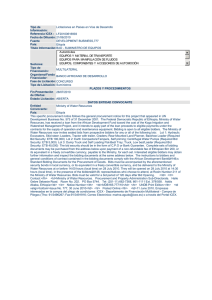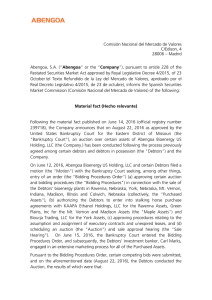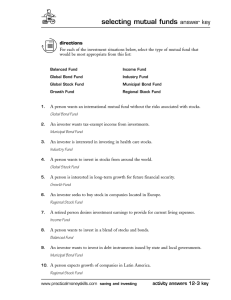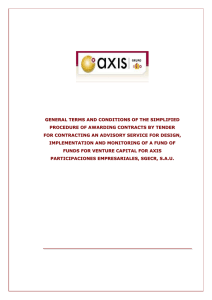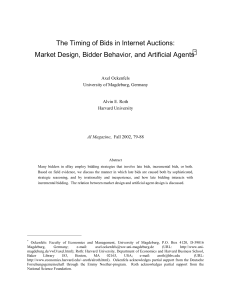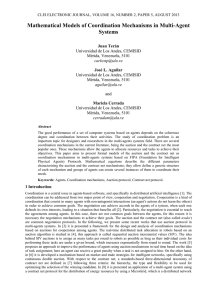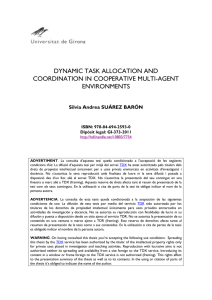Auctions manual summary (English version)
Anuncio
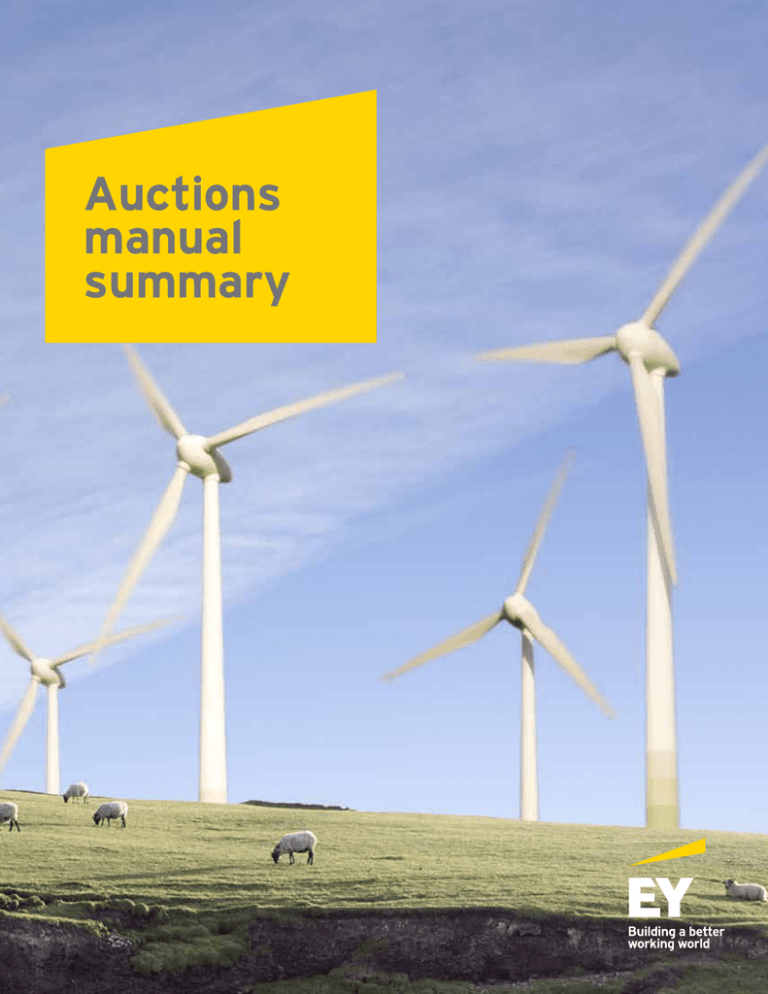
Auctions manual summary On November 19, 2015, Mexico’s Ministry of Energy published its Long-term energy Auction Manual (the Manual) in the Official Gazette. Key aspects that potential bidders should consider as they evaluate whether or not to participate in the auctions are as follows: • Long-term auctions are seen as the best way to attract investment in clean energy in Mexico • The cost of entry into this market and the associated bond requirements involve a significant investment for potential bidders • The complex bid evaluation process will cover criteria related to supply, demand, inflation, exchange rates, and price zones and will require the application of advanced modelling techniques • The Ministry of Energy expects to receive twice as many offers as the volume of energy that will be auctioned, leading to intense competition among bidders for the different products and auction zones • Bidders will need to develop specific tendering strategies in order to win the auction they participate in The purpose of the Manual is to establish the procedures, rules, and principles to be followed by bidders and the frequency with which the Long-term Auctions shall be conducted, as set forth in Guideline 14, “Medium- and Long-term Auctions” under the Wholesale Electricity Market Rules published in the Official Gazette on September 8, 2015. This Manual is part of the Market Operating Guidelines, which are subordinate to the Electricity Market Rules, which supersede this Manual. Auctions manual summary The Manual indicates that the auctions will called in April of each year, except for the first auction, which will be published in November. Under the terms of the Manual, the National Center for Energy Control (CENACE) will call an auction each year in order to sell a total volume of energy, power, and clean energy certificates (CEL, Spanish acronym) in volumes in excess of 500 MW. When volumes are less than 500 MW, by decision of the CRE, the auction in question shall be cancelled. Notwithstanding the above, the CENACE may call additional auctions when requested to do so by the Utility Supplier or by Ministry of Energy (SENER) in order to coordinate the supply of energy for fuel transportation infrastructure projects or strategic infrastructure projects aimed at meeting with the aims of Mexico’s energy policy. The Activity calendar for the first Auction shall be as follows: Activity Calendar November 10, 2015 Manual: Final COFEMER report November 11, 2015 Manual: sent to the Official Gazette November 19, 2015 Manual: published in the Official Gazette November 19, 2015 Publication of the call for bids November 30, 2015 Publication of bid guidelines January 20, 2016 Reception of purchase offers January 26, 2016 Notification of volumes to be auctioned January 29, 2016 Sale offers: pre-qualification March 29, 2016 Sale Offers: Bid economics March 31, 2016 Final ruling Products to be auctioned The Products that may be supplied under contracts that are to be awarded through Auctions as follows: Capacity: This refers to supplier commitments to maintain installed capacity and provide energy using that capacity in the short-term energy market. Power commitments shall be set forth in contracts for the generation of clean energy at a fixed rate ($/MW) over a 15year term in the power zone (not yet determined by the Energy Regulatory Commission). Cumulative energy: This refers to electricity delivered in the Real Time Market over a one-year period, measured in MWh, at the interconnection points of each Power Plant, from Power Plants with a right to receive Clean Energy Certificates (CELs). These contracts shall be for 15-year terms commencing on the start-up date of the offered commercial operations. Payment for cumulative energy shall be determined based on whether the supplier has permanent clean sources or intermittent clean sources. Suppliers with intermittent clean sources may deliver the cumulative energy at any time. a) Under Cumulative Energy contracts, Suppliers with intermittent clean sources shall receive a monthly payment equal to the Schedule Adjustment Factors multiplied by the number of MWh of energy produced on a per-hour basis. These adjustments made to the payment shall be either positive or negative and shall be determined by multiplying the amount produced on a per-hour basis by the schedule adjustment factor corresponding to the month, hour, and location in question during the year. The schedule adjustment factors shall be calculated as follows: I. The Schedule Adjustment Factors shall be calculated for each Price Zone, for each hour of the average day, and for each month of each year covered by the auction. II. In the Guidelines of each Auction, the CENACE shall publish the Schedule Adjustment Factors corresponding to each Price Zone, for each hour of the month for each year. b) Sale Offers that are associated with firm clean sources may include offers of Cumulative Energy, but if they do, the Cumulative Energy offer shall be considered constant volumes in each hour of the year and the Supplier shall not receive any monthly adjustment payments. Cumulative Energy from firm clean sources must be delivered on an hourly basis based on a fixed percentage of the committed energy of each year and at the location where the plants designated in the offer are located. 1 CELs: These are certificates issued by the Energy Regulatory Commission (CRE) authorizing the production of a specific volume of energy from Clean Energy sources. The associated contracts shall be for 20-year terms commencing on the start-up date of the offered commercial operations. As part of the Auctions, the supplier in question shall agree that each year it shall cede or transfer to the Buyer a specific number of CELs through the Clean Energy Certificate Registration, Management, and Revocation system that shall be set up by the CRE. Costs and Bonds In order to evaluate the amounts of a Bidder’s Bid Bonds, Compliance Bonds, and any other aspects related to the Bidder’s legal, technical, financial, operational capacity evaluated in terms of the total number or volume of Sale Offers submitted by a Bidder, the CENACE shall assess pre-qualification applications in the order in which they are received, and in accordance with the following considerations: a) Mutually exclusionary Sale Offers shall be assessed considering the Sales Offer containing the most stringent payment, bonding, or capacity requirements for the Bidder. b) Conditional Sale Offers or combinations of conditional and mutually exclusionary Sale Offers shall be assessed considering the combination of Sales Offer containing the most stringent payment, bonding, or capacity requirements for the Bidder. Auction participation fees: a) The cost per party to acquire Bid Guidelines shall be 5,000 monetary investment units (UDIs). b) The cost of the assessment of registration applications of Potential Buyers shall be 50,000 UDIs per Load Serving Entity. c) The cost of the assessment of Sale Offer pre-qualification applications shall be 50,000 UDIs for each bidder, plus 5,000 UDIs for each Sale Offer, combined or mutually exclusionary, submitted by the same bidder in an Auction. These payments must be made at authorized banks using the form included in the Bidding Rules. The CENACE shall not reimburse any of the above-mentioned fees for any reason whatsoever. Bid Bonds for Sale Offers Bidders who have requested pre-qualification of their Sale Offers must provide the CENACE their Bid Bond before the Offer is received and before the deadline for doing so indicated in the Auction Calendar. 2 The minimum Bid Bond amount shall be calculated for each bidder as follows: i) 300,000 UDIs, regardless of the number of Sale Offers the bidder intends to submit; plus ii) 65,000 UDIs per MWh of Power that the bidder intends to offer in the Auction on a peryear basis; plus iii) 30 UDIs for each MWh of Cumulative Energy that the bidder intends to offer in the Auction on a per-year basis; plus iv) 15 UDIs for each CEL that the bidder intends to offer in the Auction on a per-year basis. Bid Bonds shall be reduced by the amounts of bonds submitted to the CENACE to guarantee compliance with the obligations associated with the interconnection process of the Power Plants that may have been included in the Sale Offers, without the Bid Bonds being allowed to be reduced by more than 50% of the original minimum amount. Whenever a Sales Offer is backed by a bid bond and said offer is not selected, the bond shall be fully or partially released for the bidder. In the event that said Sale Offers are selected, bonds that are not required for the interconnection process shall be released after the Bidder has signed the Contracts. The release of the bonds shall be determined by subtracting the amount of the Bid Bond from the total amount of the bonds required for the interconnection process in accordance with the selected Sale Offers, excluding other bonds submitted to the CENACE. After the Bidder has submitted the Bid Bond, the CENACE shall issue the Pre-qualification Certificates corresponding to the Sale Offers, but only for the amounts corresponding to the Bidder’s Bid Bond. a) Mutually exclusionary Sale Offers: The associated Bid Bond shall be calculated by considering the highest Sales Offer in terms of the total value to be guaranteed. b) Conditioned and mutually exclusionary Sale Offers: The associated Bid Bond shall be calculated considering the highest combination Sales Offer in terms of the total value to be guaranteed. Supplier Compliance Bonds Suppliers must guarantee their compliance with their obligations under Contracts Awarded through the Auctions. The Supplier shall determine the amount of the Compliance Bond in the Contracts under which it agrees to deliver Power, Cumulative Energy, or CELs from Power Plants that have not yet been built, with said bond calculated as follows: i) 65,000 UDIs per MW of Power offered on a per-year basis; plus, ii) 30 UDIs for each MWh of Cumulative Energy offered on a per-year basis; plus iii) 15 per CEL offered on a per-year basis. Auctions manual summary The Compliance Bond may be reduced by the percentages indicated below, if the Buyer, in accordance with the Contract, has met the following requirements: Utility Suppliers shall freely determine the product volumes that they wish to acquire through Auctions, establishing the maximum price that they are willing to pay for said volumes. a) 80% of the original amount of the bond when the Supplier achieves the financial closing related to the construction of the Power Plants; b) 70% of the original amount of the bond when the issued reports indicate that the Power Plants will start-up operations before or on the Offered Commercial Operation Date; and c) 50% of the original amount of the bond when the Power Plants start up their commercial operations. The CRE may establish the maximum pricing per product that Purchase Offers must adhere to. For this purpose, the inclusion of inflation adjustment and FOREX factors, among other aspects, shall not be considered a failure to comply with said maximum prices. In addition, Purchase Offers must adhere to the following elasticity parameters: The Compliance Bond that the Supplier must submit in the Contracts under which it agrees to deliver Power, Cumulative Energy, or CELs from Power Plants that have already started up their commercial operations shall be calculated as follows: i) 32,500 UDIs per MW of Power offered on a per-year basis; plus, ii) 15 UDIs for each MWh of Cumulative Energy offered on a per-year basis; plus iii) 7.5 per CEL offered on a per-year basis. Contracts may address other cases in which the Bond submitted by the Supplier may be reduced. Contracts may also stipulate that the Compliance Bond must cover the Buyer’s rights over the Power Plants. Buyer Compliance Bond Buyers must guarantee compliance of their obligations under Contracts Awarded through the Auctions. The Compliance Bond that the Buyer must submit to the Supplier shall be calculated as follows: i) 32,500 UDIs per MW of Power offered on a per-year basis; plus, ii) 15 UDIs for each MWh of Cumulative Energy offered on a per-year basis; plus iii) 7.5 per CEL offered on a per-year basis. The Bonds must be submitted by the Buyers within 30 days after the Power Plants included in the Contract start up their operations. Bonds shall be maintained over the entire term of the Contract. Participation in the Auctions Potential Buyers: The following Load Serving Entities (Buyers) may participate in the Auctions as Potential Buyers: a) Suppliers; b) Qualified Services Suppliers; c) Suppliers of Last Resort; and d) Qualified Users. Load Serving Entities may only participate when the Clearing House is operating. During the Auctions, Purchase Offers received from Utility Suppliers shall be the first offers to be received, followed by Purchase Offers submitted by other Load Serving Entities. In this way, Purchase Offers received by the rest of the Load Serving Entities may be formulated based on the amounts, prices, and parameters of the Purchase Offers submitted by Utility Suppliers. a) 80% of the price of the total amount of each product (Purchase Offer) must be < 95% of the highest price provided by Utility Suppliers b) 60% of the price of the total amount of each product (Purchase Offer) must be < 90% of the highest price submitted by Utility Suppliers c) 40% of the price of the total amount of each product (Purchase Offer) must be < 85% of the highest price provided by the Utility Suppliers d) 20% of the price of the total amount of each product (Purchase Offer) must be < 80% of the highest price provided by the Utility Suppliers Clearing House: In order for Load Serving Entities that are not Utility Suppliers to be able to participate in Auctions, there must be a Clearing House in operation. The Clearing House shall be a corporate entity that shall administrate all contracts awarded through Auctions and perform the following activities: a) Centrally administrate the Contracts awarded by the CENACE through Auctions. b) Facilitate full enforcement of the rights and obligations assumed by the Buyers and Sellers under the Contracts awarded through Auctions. c) Act as an intermediary to ensure that Buyers receive the Products that Suppliers are obligated to deliver to them, and that the Suppliers receive payment from the Buyers. d) Administer the Compliance Bonds that must be provided by Buyers and the Suppliers. If necessary, the Clearing House may execute the Compliance Bonds. The activities and operating rules of the Clearing House, as well as the operating costs that the Clearing House shall have the right to recover, shall be set forth in detail in the Clearing House Operating Guide. Bidders: Any individual may participate in Auctions as a Bidder to offer/sell one or more of the Products being Auctioned. Whenever two or more individuals wish to jointly participate in an Auction, they may do so as a Consortium and submit their Sale Offers as a single Bidder. 3 The Power Plants with which they intend to carry out the Sale Offers must be identifiable. For such purpose, accepted Power Plants shall be those that are in their planning, development, or construction stages (existing Power Plants or new Power Plants). Cumulative Energy Bidders must comply with certain rules regarding the Power Plants that they identified in their Offers, including the rule that the capacity of the Power Plants may not be committed under any other contracts or have been pledged in guarantee of any other contracts. Also, Bidders shall not be allowed to shut down the Power Plants included in the contracts during the terms of the contracts. In addition, Bidders may create a Specific Purpose Entity to be able to enter into any Contracts that they are awarded, but they must indicate their intention to create a Specific Purpose Entity (SPE) in their Sale Offers, and provide the names of the partners and shareholders of the SPE and how the SPE’s capital will be distributed. Contracts Parties to the Contracts may, by mutual agreement, extend the contracted volume by up to an additional 10%; however, upon doing so, the parties must adhere to all other terms of the Contract. Standard Commercial Operation Date The Bidding Guidelines shall establish a Standard Commercial Operation Date for Contracts awarded through Auctions, and those dates shall correspond to January 1 of the third calendar year after the date on which the Call for Bids is published. However, if the Sales Offer is received in the calendar year after the year of the date on which the Call was published, the Standard Commercial Operation Date shall be two years after the date the Sales Offer was received. If the Power Plants have not started up commercial operations by the Offered Commercial Operation Date and the associated Supplier has met its obligation to deliver the CELs and Power, the Supplier may require a collateralized advance payment from the Buyer. Power shall be delivered following a Bilateral Power Transaction Schedule, which means that delivery of the power may only be verified before the Energy Imbalance Market is fulfilled. The amount that the Supplier may receive shall be the lesser between: a) The market value of the delivered Products, based on the most recent results of the CEL Market operated by the CENACE or the Energy Imbalance Market, as appropriate. b) The portion of the annual payment attributable to the delivered Products whose specific prices must be calculated following the procedure set forth in the Auction Manual. 4 If a Power Plant has not started up commercial operations by the Offered Commercial Operation Date, the following shall apply: a) In order to offset the increase in contract default risk, the Bidder shall be required to raise its bid bond by at least 10% of the original amount for each month of default in respect of the Commercial Operation Date. b) A penalty equal to 5% of the monthly payment corresponding to the offered price during each month of default. Inflation and foreign currency adjustments All payments resulting from the Contracts awarded through Auctions shall be adjusted by the Utility Service Suppliers or by the Clearing House in accordance with the adjustment formulas and factors established in the Manual. All Sale Offers must specify whether the Bidder prefers its payments to be indexed in Mexican pesos or in U.S. dollars. To evaluate Sale Offers indexed in U.S. dollars, the Offered Price shall be translated into a price equal to the Offered Sales indexed in Mexican pesos. The Offered Price of Sale Offers that have been selected in the Auctions and formalized through the corresponding Contract shall be adjusted by applying an initial factor reflecting the variance in the prevailing peso/dollar exchange rate between the date on which the Offer was received by the CENACE and the Offered Commercial Operation Date. The purpose of this adjustment is to maintain the real value of the Offer. The adjustment factor shall be applied to Sale Offers indexed in U.S. dollars and in Mexican pesos. Auction procedures Auctions shall be carried out in accordance with the terms of the Electric Industry Act and its Regulations, the Electricity Market Guidelines, the Long-term Auction Manual, and the Bid Guidelines for the Auction in question. Anyone may participate in the Auctions, provided that the would-be bidder meets the requirements set forth in the Long-term Auction Manual and the Bid Guidelines, and the bidder is not prohibited from doing so in terms of any applicable legislation. Auctions shall be carried out in Spanish. All information and documentation that Interested Parties, Potential Buyers, and Bidders are required to submit to the CENACE must be submitted in Spanish. Any documents in a foreign language must be accompanied by a certified translation into Spanish. In order to ensure transparency and demonstrate the legality of the Auctions, a so-called “social witness” (a trained citizen that oversees the bid process) shall be present at all Auctions. Auctions manual summary Auctions shall be carried out following the terms set forth in the corresponding Bid Guidelines, which shall include at least the following stages: Sale Offers shall be submitted to the CENACE together with the respective Pre-qualification Certificate and economic offer. The technical offer must include the following information: i. Auction invitation stage (publication of the call to bid, publishing of the bid guidelines, and a clarification meeting); ii. Determination of the Products to be Auctioned (registration of buyers, submission of Purchase Offers from Utility Suppliers, and subsequently from other Load Serving Entities, and the determination of the Products and quantities thereof to be Auctioned); iii. Sale Offer pre-qualification stage (Sale Offer Pre-qualification Application, delivery of Bid Bonds, and issue of Sales Offer Prequalification certificates); iv. Reception and evaluation of the economics of each Sale Offer; v. Ruling and contract awarding stage; a) A description of the product package being offered b) The Offered Commercial Operation Date c) The related interconnection zone d) If Power is being offered, the Power Zone e) If Cumulative Energy is being offered, the names and a description of the Power Plants and the exact percentage of production, the Price Zones, and if applicable, the Export Zone. f) If applicable, a statement indicating that the Sales Offer is dependent on the selection of another Sales Offer or Offers submitted in the Auction by the same Bidder. g) If applicable, a statement indicating that the Offer is mutually exclusionary. h) The bid bond. The call to bid shall be executed by the CENACE and calls to bid shall be published on the SENER’s and the CENACE’s websites after the Market Information System is in operation. The bid guidelines shall also be published on both websites. The determination of the Products to be auctioned shall include the requirements and deadlines that potential buyers must follow for their registrations, as well as the purchase offers submitted by Utility Suppliers and the purchase offers submitted by other Load Serving Entities. Notification of accepted purchase offers must be published within 50 business days after the day the Purchase Offers are received. After the Purchase Offers are accepted and the amounts, pricing, and parameters are calculated by the CENACE, the CENACE shall notify all interested parties to that effect. The terms of Sales Offer pre-qualifications include an outline of the general aspects that Bidders must consider in order to pass the prequalification stage. Sales Offer Pre-qualification Certificates shall be issued by the CENACE after the CENACE has verified that the Bidder has met the following requirements: a) The Bidder has made the required payment to receive the respective Bid guidelines b) The Bidder has made the required payments for its evaluation conducted as part of the pre-qualification application process c) The Bidder has the legal, technical, financial, and operational means to complete the Sales Offer d) The Bidder has provided the Bid Bond in respect of the Sales Offer. Economic offers must specify the following: a) The respective Pre-qualification Certificate b) The price offered for the Product package expressed in Mexican pesos and on a per-year basis. c) The bidder’s decision regarding whether it will opt to receive its payments in Mexican pesos or indexed in U.S. dollars. d) The interconnection status of the Power Plants associated with the Sales Offer. After the CENACE has evaluated all Sale Offers and has selected those that will be accepted, the CENACE shall issue the corresponding Ruling in which it will describe and award the contracts, and where it shall also provide a complete description of the models used to select the winning bid. The bidding process shall require a great deal of care and attention to detail for potential bidders to ensure that they comply with all bid rules and guidelines and to prevent inconsistencies in the information that they submit that would preclude them from participating in long-term auctions. EY’s professionals have the right experience and expertise to help you successfully complete the bid registration, pre-qualification, and bond deposit stages of your bid, and to advise you during the signing of contracts you are awarded through Mexico’s energy auctions. 5 EY | Assurance | Tax | Transactions | Advisory About EY EY is a global leader in assurance, tax, transaction and advisory services. The insights and quality services we deliver help build trust and confidence in the capital markets and in economies the world over. We develop outstanding leaders who team to deliver on our promises to all of our stakeholders. In so doing, we play a critical role in building a better working world for our people, for our clients and for our communities. EY refers to the global organization, and may refer to one or more, of the member firms of Ernst & Young Global Limited, each of which is a separate legal entity. Ernst & Young Global Limited, a UK company limited by guarantee, does not provide services to clients. For more information about our organization, please visit ey.com. Contacts Alfredo Álvarez [email protected] Rafael Aguirre [email protected] Rodrigo González Luna [email protected] LoÏc Le Gall [email protected] Santiago Villarreal [email protected]

